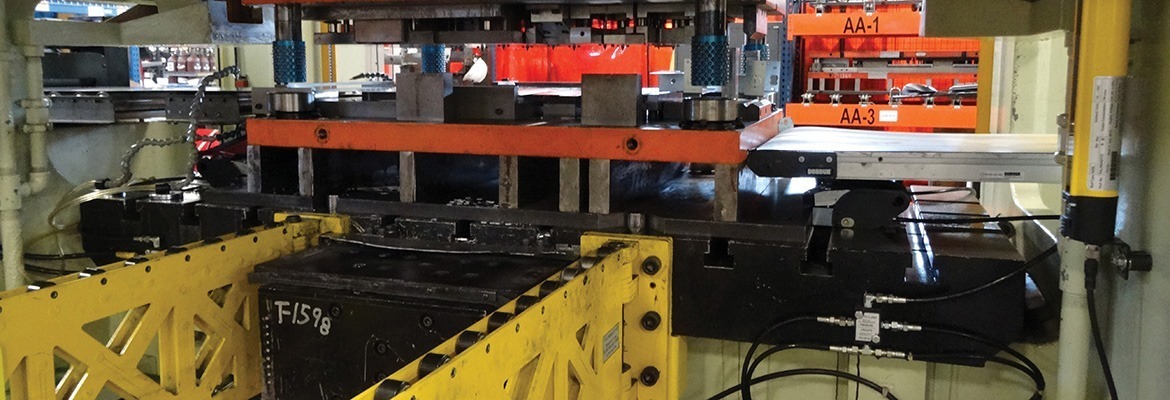One of the biggest challenges that most manufacturers face is changing or swapping out one set of tools or dies in industrial press machines for another, which leads to significant production delays, increased labor costs, and a high percentage of errors.
This is where Quick Die Change (QDC) Systems come to light – a process used in manufacturing to streamline tool or die changeover with a promise to minimize downtime and maximize productivity.
The essence of QDC lies in its ability to transform what was once a bottleneck in production into a seamless, efficient process.
Enhancing QDC Systems’ efficiency is the concept of Single-Minute Exchange of Dies (SMED). It is a revolutionary approach that aims to reduce the time to exchange dies to under 10 minutes. This was originally developed to improve manufacturing processes in the automotive industry but has found widespread application in various sectors.
Continue reading to discover how these emergences have prompted significant improvements in efficiency and productivity in the manufacturing industry.
Benefits of Implementing QDC
The implementation of Quick Die Change systems is more than just a technological upgrade, instead, it is a strategic move that can lead to significant improvements in the manufacturing industry.
Here are the benefits of implementing QDC Systems:
Reduced Downtime and Increased Productivity
QDC systems streamline the die change process, significantly reducing the time it takes to switch from one production run to another. This efficiency boost leads to more operational hours and increased overall press shop productivity.
Enhanced Flexibility
With faster die changes, manufacturers can switch between different production runs more quickly and efficiently. This allows for a more flexible response to market demands and the ability to handle a variety of short runs without significant time loss.
Improved Safety
Manual die changes can be hazardous as they involve dangerous actions, such as heavy lifting and pressure setting, increasing the risk of accidents. QDC systems typically automate much of the process, reducing the probability of confronting injury and in turn, improving overall workplace safety.
Cost Savings
While there is an initial investment in QDC technology, the long-term savings cannot be overstated. Reduced downtime means more production output, and these efficiency gains often lead to a quick return on investment.
Consistent Product Quality
QDC systems allow for precise and repeatable die changes, which helps maintain consistent product quality. The precision in this reduces the chances of errors and defects, leading to a better quality end product, and superb customer satisfaction.
Lower Labor Costs
The automation and streamlining of QDC systems reduce the need for a large workforce and specialized skills, as the system simplifies and speeds up the changeover process. This, in turn, decreases labor costs due to minimized overtime and training expenses.
Energy Efficiency
Implementing QDC systems contributes to energy savings by reducing the idle of machines, which is achieved through faster and more efficient die changeovers. This impact can be both cost-effective and environmentally beneficial, as it leads to less energy wasted during non-production periods.
Enhanced Competitive Advantage
Adopting QDC systems can give manufacturers a competitive edge by allowing them to meet customer demands more quickly, adapt to changing market needs, and deliver high-quality products consistently. This ability favorably positions companies in the marketplace.
Key Components and Technologies
Quick Die Change (QDC) System is not just a single entity but a composition of various technological elements that work in unison. While it is designed to promote effectiveness and efficiency, it won’t properly function to deliver high-quality results if one piece is missing. Thus, jeopardizing the entire process.
Here are the key components and technologies equipped in QDC Systems:
Diverse Components of QDC
At the core of any QDC system are several vital components, each playing a unique role in ensuring smooth and efficient die changes. These include:
- Die Clamps: Used for securing dies to the press, clamps are critical for quick and safe die changes. They come in various types, including hydraulic and mechanical clamps.
- Die Lifters: These devices assist in the movement and positioning of dies within the press, significantly reducing manual effort and enhancing precision.
- Die Carts: These facilitate the transport of heavy dies to and from the press, significantly reducing manual labor and risk of injury.
- Consoles and Controllers: Serving as the control center, these components allow for precise control and coordination of the QDC process.
- Bolsters: Serve as interchangeable parts of the press bed, pre-fitted with dies to achieve rapid tool changeover time.
- Hydraulic Power Units: Provides the necessary power to operate hydraulic components of the QDC system, ensuring efficient and consistent operation.
- Quick Connect/Disconnect Couplings: In systems with hydraulic elements, these couplings facilitate speedy attachment and detachment of hydraulic lines, enhancing the efficiency of die changes.
Technological Advancements in QDC
Technological innovation is the driving force behind the effectiveness of QDC systems. These include:
- Hydraulic or Magnetic Clamping: These methods provide quicker and more secure die fixation than traditional methods, hence significantly reducing setup time. The efficiency of these clamping systems is important for rapid die changes.
- Automated Die Handling: This technology speeds up the die handling process and enhances safety by minimizing the need for manual intervention, thus streamlining the entire changeover procedure.
- Control Systems: Advanced control systems, such as programmable logic controllers (PLCs) and touchscreen interfaces, offer precise control and coordination of the QDC process, thereby improving overall efficiency and user-friendliness.
- Safety Mechanisms: Incorporating technologies like sensors, guards, and interlocks, these mechanisms ensure safe operations during die changes which provides essential protection for workers and equipment.
- Automated Die Identification: Innovations such as RFID tags or barcode systems for die identification contribute to accuracy and reduce setup errors, ensuring the correct die is used for each production run.
- Positioning Systems: Tools like laser alignment systems assist in accurately and efficiently positioning dies, which is a critical factor for maintaining consistent product quality.
- Integration with Industry 4.0: The integration of QDC systems with smart technologies facilitates better monitoring, control, and optimization of the die change process, aligning with modern manufacturing trends.
- Maintenance and Diagnostic Tools: These built-in features aid in system health monitoring and maintenance scheduling, which are vital for achieving consistent performance and longevity.
Overcoming Challenges and Best Practices
The benefits of QDC implementation cannot be overstated – it ensures efficiency due to increased productivity and decreased downtime. However, despite the overwhelming convenience that this system can provide to manufacturers, it is not immune to certain challenges.
Here’s a table outlining the common challenges that come with the system, and the best practices to counteract each dilemma:
| CHALLENGES | SOLUTIONS |
| Resistance to Change | Encourage a culture that values innovation to mitigate resistance and educate employees on the benefits of QDC systems. |
| Initial Costs | Perform a detailed financial analysis to highlight the long-term savings and efficiency gains, demonstrating the value of the investment. |
| Training Requirements | Invest in comprehensive and ongoing training for employees to ensure proficiency and reduce apprehension about using new technology. |
| Integration with Existing Systems | Carefully assess and plan the integration of QDC systems with existing machinery, addressing compatibility issues and necessary modifications. |
| Downtime During Implementation | Plan the QDC implementation process to minimize production disruptions and schedule installations during low-demand periods. |
| Maintenance and Upkeep | Establish a regular maintenance schedule and allocate resources for the upkeep of QDC systems to ensure their longevity and consistent performance. |
| Cultural Shift in the Workplace | Foster an organizational culture that embraces change and continuous improvement, aligning with the adoption of QDC systems. |
| Reliability Concerns | Implement a system for ongoing performance monitoring and gather feedback to address any reliability issues and ensure the system meets diverse manufacturing needs. |
Future Trends in Quick Die Change Technology
The manufacturing landscape is continually evolving, and so is the technology behind QCD systems. For this reason, staying ahead of the curve and emerging trends is vital for companies to remain competitive and efficient.
So, we’ve curated a list of the most promising trends that are set to shape the future of Quick Die Change technology:
Integration with Industry 4.0
The future of QDC is deeply intertwined with the principles of Industry 4.0. Expect to see a surge in the use of smart sensors, cloud computing, and big data analytics, all aimed at enhancing the efficiency of the die change process. This integration will allow for more precise control and monitoring, leading to a significant reduction in setup times and an increase in overall equipment effectiveness.
IoT and AI in Manufacturing
The Internet of Things (IoT) and Artificial Intelligence (AI) are poised to play a pivotal role in the evolution of QDC systems.
By harnessing these technologies, QDC systems can achieve predictive maintenance, real-time monitoring, and automated adjustments. This will boost efficiency and minimize downtime, making the manufacturing process more reliable and less prone to errors.
Advanced Automation Solutions
Automation is the cornerstone of modern QDC systems. In the future, we can expect even more sophisticated automation in manufacturing solutions, including the integration of robotic arms and automated guided vehicles (AGVs) for fully automated die changes. These advancements will further reduce the need for manual intervention, enhancing safety and consistency in the manufacturing process.
Customization and Flexibility
As the demand for customized and flexible manufacturing solutions grows, QDC systems will evolve to meet these needs. This might include modular designs that can be easily adapted for different machines and processes, ensuring that manufacturers can quickly respond to changing market demands.
Sustainability Focus
With a growing emphasis on sustainable practices, future QDC technologies may also focus on energy efficiency and reducing the environmental footprint of efficient lean manufacturing operations. This could involve optimizing energy use during die changes and utilizing materials and processes that are environmentally friendly.
Augmented and Virtual Reality Integration
The use of AR and VR technologies is expected to rise for training and simulation in QDC systems. These technologies can provide virtual hands-on experience for training or for planning and testing die changes in a simulated environment before actual implementation.
Enhanced Connectivity and Communication
The integration of QDC systems with broader manufacturing systems and supply chain management through enhanced connectivity and communication protocols is another anticipated trend. This will facilitate better coordination and efficiency across different stages of the manufacturing process.
Embracing the Future of Quick Die Change Systems with PFA
The integration of Quick Die Change Systems represents a significant stride towards a lean and efficient manufacturing environment. For this reason, it is evident that the capabilities of such systems are not just incremental but are transformative improvements.
In any industry that relies heavily on manufacturing productivity, efficiency and precision are eminent, thus streamlining factory operations with effective and reliable systems is A MUST. That said, getting hold of dependable equipment is your #1 priority.
QDC systems are not just an operational upgrade but a strategic investment in manufacturing’s future. If you’re looking for QDC solutions tailored to meet the unique needs of your manufacturing processes, PFA Incorporated stands out as a leader in the field.
Our systems are designed to improve operational efficiency and ensure sustainability and adaptability in a rapidly evolving manufacturing landscape. If you’re ready to take your manufacturing capabilities to the next level and position your business at the forefront of industry innovation, reach out to us NOW!


